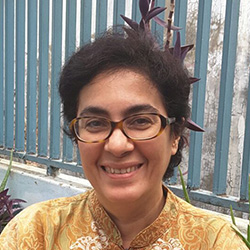Mapmaking 101
Large scale map-making is an epic process. The landscapes are pre-stratified- defined into blocks-geomorphology – which defines the earth’s physical features, climate, soil type, catchment area, and elevation class. This data is then interpreted using a combination of supervised classification- where image software is guided by the user to specify land cover of interest- as well as manual digitization, which requires extensive crosschecking. The cartographers assess information gathered from field surveys, looking at every vegetation type, plant structure, its distribution, and the landscapes successional stages – or how the vegetation naturally regenerate over time .
The various types are then color-coded using symbols based on the cartographic principles of ecological mapping, with one color representing one vegetation type and its succession. For example, a solid green color is assigned to lowland forest, and its first degradation level; logging is represented by green mixed with horizontal white stripes, indicating the depletion of the original forest type.
"CIFOR’s vegetation maps provide very useful information for the implementation of the One Map Policy"
Supporting the One Map Policy
Smaller scale ecological mapping in Indonesia goes back to the 1980s, with larger scale maps making their entry in the early 2000s. In 2013, a new government regulation directed regencies to generate operational maps at a larger-scale of 1:50,000, in order to improve the level of land management.
In a bid to settle land disputes, recognize Indigenous rights and better conservation efforts, current President of Indonesia, Joko Widodo, took the idea one step further when he announced a One Map Policy in 2016.
As well as regulating a standardization of maps, the policy includes ambitious plans for a centralized geospatial information database and online portal, to aid government in better planning and decision making.
Vegetation maps are critical for any land use decisions, as they reveal the health of an environment and livelihood potential. The growth of trees and plants, and their condition, indicate how fertile the soil is and the availability of groundwater. For example, a landscape rich in diverse vegetation means a provision of ecosystem services– from clean water to an array of foods from fish to fruits- is provided for free to its people and wildlife.
“It is an operational scale that is detailed enough to be used in land management”
“CIFOR’s vegetation maps provide very useful information for the implementation of the One Map Policy and could consider using these maps under a new theme to be included in their national database, “says Nurwadjedi, Deputy Head of The Geospatial Information Agency (BIG), who is overseeing the country’s mapping standardization work.
Laumonier believes West Kalimantan’s vegetation maps can benefit both the public and private sector, who can use them to determine land allocation, manage whole ecosystems, and recognize specific forest types and areas for conservation, as they detail both logged-over and pristine forests.
What’s more, it can also identify various peat depths through the identification of four different swamp forest types. “It is an operational scale that is detailed enough to be used in land management,” says Laumonier. This has global significance. According to the UN, the protection and restoration of peatlands is vital ‘towards the transition of a low carbon and circular-economy society.’
"We want the maps to be accessible to everyone"
Making a real difference to local decision-making
CIFOR is working with the Ministry of Environment and Forestry to compare and resolve differences in classification, data sources, and base maps. In West Kalimantan, the province is already looking to use the maps in future planning to help preserve and restore the provinces natural landscapes.
“These detailed vegetation maps can be very useful in assisting our provincial government review its land use practices and better guide the preparation of our next mid-term development plan and forest management units,” says Yuslinda, a senior official from the Provincial Development Planning Agency (Bappeda).
“We want the maps to be accessible to everyone,” adds CIFOR’s principal landscape ecologist, Yves Laumonier. To do just this, his team have used freely available Landsat images, instead of higher resolution maps that come with a cost to boot.
Though the maps are extensive, to Laumonier the work can always be improved, “the good news is that now we can start using new free satellite data with better resolution, such as Sentinel 2,” he adds.
The West Kalimantan vegetation maps will go live online next month. If you have any comments or queries, please reply in the comment box below.
This research was supported by EU and USAID
Copyright policy:We want you to share Forests News content, which is licensed under Creative Commons
Attribution-NonCommercial-ShareAlike 4.0 International (CC BY-NC-SA 4.0). This means you are free to redistribute our material for non-commercial purposes. All we ask is that you give Forests News appropriate credit and link to the original Forests News content, indicate if changes were made, and distribute your contributions under the same Creative Commons license. You must notify Forests News if you repost, reprint or reuse our materials by contacting
forestsnews@cifor-icraf.org.















